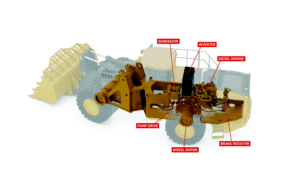
Deere & Co. is doing its part to change the jobsite perception of hybrid equipment as inferior. The Moline, Ill.-based manufacturer is the latest supplier to build diesel-electric construction machines, starting with its 644K hybrid wheel loader, set to go on sale next year. An even more efficient 944K loader will join the mix in 2013. With these moves, the Deere line will join an elite category of construction vehicles that are capitalizing on hybrid know-how.
Deere is using technology—marrying an internal-combustion engine with electric motors—that is familiar in some automotive, mining and locomotive vehicles but rare in construction equipment. The costs are still high, but manufacturers believe that as volumes of electrical components rise, more heavy-duty hybrids will arrive in the next five to 10 years.
“There is an increasing need—and especially where fuel prices have been going—for contractors to help contain their costs,” Domenic Ruccolo, Deere's senior vice president of sales and marketing, told ENR in Las Vegas at this year's CONEXPO, where the company unveiled its 644K and 944K hybrids. “There are applications where we think electrification brings more efficiency than others, and we think wheel loaders is one of those.”
Wheel loaders are notorious fuel hogs. A large, quarry-class machine, running two or three shifts, consumes between 100 and 200 gallons of diesel per day. At current fuel prices, that can add up to $200,000 per year. As fuel costs go up, so does the overall operating cost of running this size machine, which alone can cost up to $500,000 to buy. Deere thinks the repetitive duty cycle of loaders—that is, drive up to the pile, scoop, back away from the pile, dump—is a perfect fit for a hybrid.
With its first hybrids, Deere is targeting fuel efficiency gains of 15% to 20% on its 644K and 25% to 30% on its 944K. With the 644K, Deere takes an existing machine in its lineup and hybridizes it. The hybrid 944K is an all-new machine.
How It Works
Deere's 944K hybrid starts with a 13.5L diesel engine that produces up to 600 hp. It connects to two generators, each of which powers two motors, one at each wheel. Sandwiched between the engine and generators is a pump drive, a simple gearbox that grabs power from the engine's flywheel to drive the hydraulic pumps for the bucket and steering. The pumps run 20% faster than engine speed; the generators run at three times engine speed.
The generators send AC power to an inverter assembly, which converts the power to DC current to run accessories, then switches it back to AC to run the four outboard electric wheel motors. Overall, the system runs at 700 volts. A computer can sense when the wheels are slipping and adjust the power to boost traction.
Though it has no traditional energy storage, the 944K captures some regenerative braking when the machine is slowing down by sending power back to the generators to drive the hydraulics. Unused energy is “cooked off” in brake resistors.
By using electrical energy to produce traction, the engine's workload goes down, boosting efficiency and reducing emissions. If the federal government imposes fuel-economy regulations on off-road machines to cut greenhouse gases—and many expect that it will someday—hybrids offer a solution. The 944K's engine spins at a relatively constant speed of about 1,800 rpm, which allows Deere to use a smaller engine to do the same amount of work as a larger one. It also eliminates the need for a torque converter to transmit power to the wheels.



Post a comment to this article
Report Abusive Comment